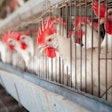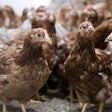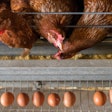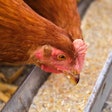
It almost goes without saying that COVID-19 has disrupted everything, but perhaps one of the most important disturbances to life as we know it -- and one that, in some areas, has resulted in some quite extreme situations -- is disrupted food supplies.
While finding what we are used to finding on supermarket shelves has been far from easy for many over recent weeks, greater difficulties could still be around the corner.
Panic food buying has resulted in huge uplifts in some sectors, bringing a spike in sales, but this is not positive long-term. Other sectors have seen their sales almost collapse. And while these may be the very immediate effects of the novel coronavirus on the food industry, as the virus spreads, labor shortages, already apparent in some sectors, will increasingly bite, impacting not only production and processing but also logistics.
Market conditions are rapidly changing, making planning difficult. Stay-at-home advice issued around the world has resulted in in an increase in food consumed in the home in many countries and the collapse, or near collapse of the restaurant and catering sector.
For those food producers supplying the latter, key is adapting their offering to retail channels, but this is easier said than done. Not only do retailers have their supply contracts in place, but where can producers normally selling to restaurants find basics, such as packaging, when all sectors are so affected.
Within the U.K., for example, around half of the value in the supply chain comes from out-of-home eating and, according to the country’s National Farmers Union (NFU), the imbalance in supply has manifested itself across all sectors, particularly dairy, poultry, potatoes and beef.
It notes, for example, that there has been huge retail demand for ground beef and forequarter products though the normal retail product ranges. The shutdown of burger restaurants will ease this, but not solve the imbalance without quick action.
Battling adversity
Connections must be made between market, logistics and product format to overcome this change. If these connections can’t be made food will simply be lost. Various strangely packaged products have started to appear in my nearest supermarket, suggesting that at least some products destined for the restaurant channel are finding their way to retail. To overcome packaging concerns, my local small grocery store is now selling eggs in burger boxes.
And there are all sorts of stories of how producers are getting their food to market. One London home delivery dry cleaning business, for example, has started a food delivery services, making use of its fleet of vans to deliver eggs, fruit and vegetables. An admirable example of a business adapting to changed circumstances and helping to keep people fed.
In many developed countries there is enough food to keep people fed, but whether it is in the right format, or can reach the consumer, is another matter, and bottlenecks do have the potential to lead to food shortages.
More demand, fewer workers
Self-isolation, to help minimize disease spread, has already disrupted numerous businesses and has the potential to seriously harm the food supply, despite those working in the sector being classified as “essential” workers.
In some countries, food producers are looking to other sectors to help overcome the spike in demand of recent weeks, and also to cover absences caused by self-isolation.
U.K. poultry producer Moy Park has said: “There has been a noticeable increase in grocery sales as people practice social distancing and self-isolate. This has resulted in higher demand for chicken produce and with it, opportunities in the sector to meet this demand.”
A similar call for labor has been made by fellow U.K. company Cranswick, which recently opened one of the largest poultry processing plants in the country, and which has called on workers from the hospitality sector to help it “feed the nation.”
Market barrier
But moving from one sector to another is not always that easy. The U.K. government is financially supporting all workers unable to go to work, and there is perhaps, little incentive to take up a new position when much of your salary is covered by the government. In some countries, some employers are offering bonuses for those employees that do turn up at the workplace.
Various remedies for labor shortages have been proposed, and the U.K.’s NFU has been looking to help workers transition. In the fruit and vegetable sector, for example, it says that there will be thousands of vacancies opening up and it is calling on students and anyone looking for work to help to keep things moving.
Difficulties are not simply restricted to individual markets. The Food and Agriculture Organization (FAO) points out that millions of people around the world depend on international trade for their food security and livelihoods. It notes that as countries around the world move to enact measures aimed at halting the accelerating COVID-19 pandemic, care must be taken to minimize potential impacts on the food supply or unintended consequences on global trade and food security.
The efforts made by the food and industries and others during the COVID-19 pandemic are admirable, but when circumstances begin to return to normal, how well positioned will any of these businesses be to return to business as normal and to keep supplying us with food? Assuming that a company has survived, will it have the stock in place to continue producing. This has already become evident in the supply of hatching eggs and day-old chicks. Once birds currently on the farm are sent to slaughter, how will they be replaced if chicks are sourced from overseas?
Given the shift to retail, will businesses be able to respond, if and when, the restaurant sector comes back to life? Will there be enough money to ride out the current crisis and even if there is, will there be funds for new investments? How many clients will have gone under?
There may be some comfort to be drawn from the fact that while consumers seem to have cut spending across sectors, this had not been the case with food. And cooking at home might even generate a new interest in looking for higher quality products. But food businesses will need to think very carefully both in the short- and longer-term, if they want to still be in business once life begins to return to normal, and the longer crisis continues, the harder this will be.
View our continuing coverage of the coronavirus/COVID-19 pandemic.
















